
In Greco-Roman mythology, Aeneas was a Trojan hero, the son of the Trojan prince Anchises and the Greek goddess Aphrodite. His father was a first cousin of King Priam of Troy, making Aeneas a second cousin to Priam's children. He is a minor character in Greek mythology and is mentioned in Homer's Iliad. Aeneas receives full treatment in Roman mythology, most extensively in Virgil's Aeneid, where he is cast as an ancestor of Romulus and Remus. He became the first true hero of Rome. Snorri Sturluson identifies him with the Norse god Vidarr of the Æsir.

St John's Co-Cathedral is a Roman Catholic co-cathedral in Valletta, Malta, dedicated to Saint John the Baptist. It was built by the Order of St. John between 1572 and 1577, having been commissioned by Grand Master Jean de la Cassière as the Conventual Church of Saint John.
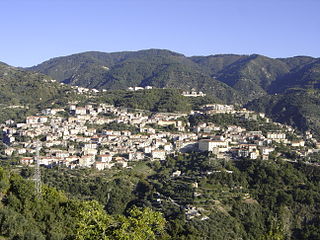
Taverna is a comune and town in the province of Catanzaro in the Calabria region of Italy. It is located at the feet of the Sila mountain range.

Mattia Preti was an Italian Baroque artist who worked in Italy and Malta. He was appointed a Member of the Order of Saint John.

St Augustine Church is one of the churches built during the creation of the new city of Valletta, Malta.

Francesco de Mura was an Italian painter of the late-Baroque period, active mainly in Naples and Turin. His late work reflects the style of neoclassicism.

The Church of St Catherine of Alexandria, commonly known as the Church of St Catherine of Italy is a Roman Catholic church in Valletta, Malta. It was built by the Hospitaller Langue of Italy and it serves as the parish church of the Italian community of Malta.

The Church of St George is a 16th-century baroque Roman Catholic parish church located in Qormi, Malta.

Saint George on Horseback is an oil painting by Mattia Preti painted in 1658. It is the altarpiece of the Chapel of the Langue of Aragon in St. John's Co-Cathedral, Valletta, Malta. The painting was Preti's first work in Malta, and it is regarded as one of his masterpieces and one of the best examples of Neapolitan Baroque art.

St John the Baptist Wearing the Red Tabard of the Order of St John is an oil on canvas painting by Italian painter Mattia Preti, from 1671. The painting has the dimensions of 98 x 78 centimeters. It is in the collection of MUŻA in Valletta, Malta.

The Plato and Diogenes is an oil on canvas painting by the Italian Baroque painter Mattia Preti, executed c. 1688. It is housed in the Pinacoteca of the Capitoline Museum in Rome.
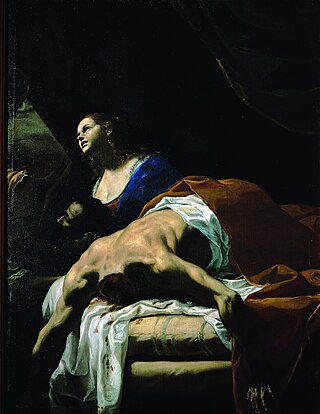
Judith and Holofernes is an oil on canvas painting by Italian artist Mattia Preti, datable to around 1653–1656. It is held at the Museo di Capodimonte, in Naples.

Madonna of Constantinople is a c. 1656 oil on canvas painting by Mattia Preti. It was the first of many works commissioned as ex-votos for freeing the city from the plague of 1656 – they all showed the Madonna with a selection of the city's patron saints, in this case Joseph, Januarius, Roch, Nicasius and Rosalia (centre). It now hangs in the Museo nazionale di Capodimonte in Naples.

Saint John the Baptist is a c.1653-1656 oil on canvas painting by Mattia Preti, now in the Museo nazionale di Capodimonte in Naples.
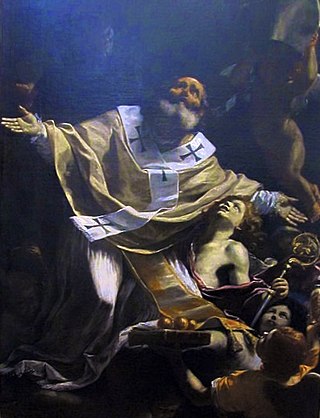
Saint Nicholas is a c. 1653 painting by Mattia Preti, the first work he produced after moving to Naples and showing the three gold balls which are a traditional attribute of the saint. It is now in the Museo nazionale di Capodimonte in the same city. He also produced a larger version of the work in 1657 which is now in the Pinacoteca civica in Fano, with an early copy after the Capodimonte version now in the church of Santa Teresa degli Scalzi in Naples.

The Banquet of Absalom is an oil on canvas painting by Mattia Preti, created in c. 1660–1665, now in the Museo nazionale di Capodimonte in Naples. It illustrates a passage from chapters 13 and 14 of 2 Samuel in the Old Testament, in which King David's son Absalom avenges the rape of Absalom's sister Tamar two years earlier by inviting her rapist Amnon to a feast, getting him drunk and then killing him.
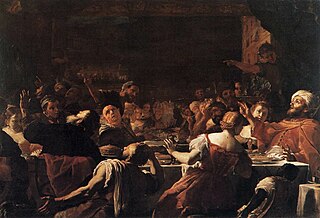
Belshazzar's Feast is a circa 1660-1665 oil on canvas painting by Mattia Preti, now in the Museo nazionale di Capodimonte in Naples. It shows a scene from chapter 5 of the Book of Daniel.
Christ and the Canaanite Woman is a c. 1650 oil on canvas painting by Mattia Preti. It and another work by Preti showing Christ with a single woman were both recorded as being in the Certosa di San Martino in Naples in 1806, but were split up the following year when Adultery was acquired by the Real Museo Borbonico and Canaanite passed to the church of Sant'Efremo Nuovo. In 1828 the two works and 38 others were given to the Museo della Regia Università degli Studi in Palermo, Sicily by Francis I of the Two Sicilies and they both now hang in the Palazzo Abatellis in the same city.

The Return of the Prodigal Son is a 1656 oil on canvas painting by Mattia Preti, now in the Museo nazionale di Capodimonte in Naples.
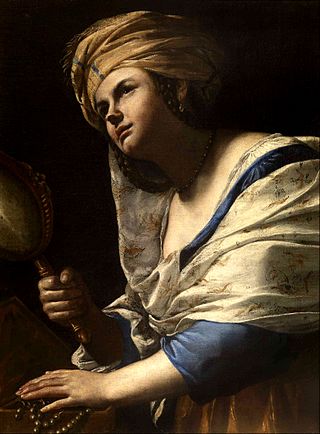
Vanitas is a 1650-1670 oil on canvas painting by Mattia Preti, now inventory number 9283 in the Uffizi in Florence, for which it was bought in 1951 from a private collection. Art historians diasgree on whether the painting is a fragment of a larger work or retains its original dimensions, as well as whether it is a general vanitas or depicts Mary Magdalene.



















